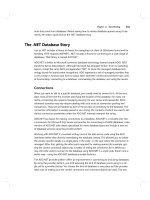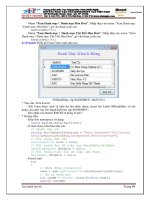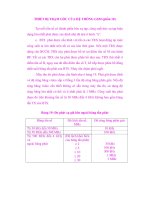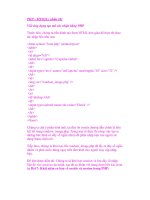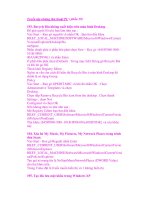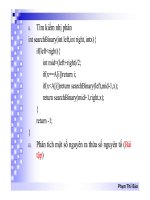javawstutorial phần 10 pps
Bạn đang xem bản rút gọn của tài liệu. Xem và tải ngay bản đầy đủ của tài liệu tại đây (236.17 KB, 51 trang )
ADD USER 85
The extension of the third TelephoneNumber.
-telephone3.number
The telephone number suffix, not including the country or area code, of
the third
TelephoneNumber. If a third TelephoneNumber is specified, the
number is required; it must be specified either on the command line or in
a properties file.
-telephone3.URL
The URL of the third TelephoneNumber (the URL that can dial this num-
ber electronically).
-emailType | -email1.type
The type of the first EmailAddress. The type is required; it must be spec-
ified either on the command line or in a properties file. It can have either
of the following values:
HomeEmail or OfficeEmail.
-emailAddress | -email | -email1.address
The first email address. The first email address is required.
-email2.type
The type of the second EmailAddress. If a second EmailAddress is spec-
ified, the type is required; it must be specified either on the command line
or in a properties file. It can have either of the following values:
HomeEmail or OfficeEmail.
-email2.address
The second email address.
-email3.type
The type of the second EmailAddress. If a third EmailAddress is speci-
fied, the type is required; it must be specified either on the command line
or in a properties file. It can have either of the following values:
HomeEmail or OfficeEmail.
-email3.address
86 ADMINISTERING THE SERVICE REGISTRY
The third email address.
Examples
The following command loads the User properties from the file Jane-
Smith.properties
in the user’s home directory.
admin> add user -load ~/JaneSmith.properties
The following command (all on one line) specifies the minimum properties
required to create a User.
admin> add user -ln Smith -postaltype Office \
-street “Smith Street” -phonetype Office \
-number 333-3333 -emailtype OfficeEmail \
-emailaddress
cd
Changes the RegistryPackage location.
Synopsis
cd {locator | URN}
Description
Change directory (metaphorically) to the RegistryPackage at the specified path
or with the specified URN.
Change to a specified URN when there are multiple
RegistryPackage objects
with the same path (for the current locale).
Operands
locator
The path of names of registry objects from the root of the repository to an
object in the repository, with each name preceded by a forward slash (
/).
CHOWN 87
For example, the locator for the userData RegistryPackage that is a
member of the
registry RegistryPackage (which is not itself a member
of any
RegistryPackage)is/registry/userData, and the locator for
the
folder1 RegistryPackage that is a member of the userData Regis-
tryPackage
is /registry/userData/folder1.
If you used the
-root option to specify the RegistryPackage locator
when you started the Admin Tool, the locator value is relative to that root.
URN
The URN of the RegistryPackage, which must be a URN starting with
urn:.
Examples
The following command changes the directory to the RegistryPackage with the
URN
urn:uuid:92d3fd01-a929-4eba-a5b4-a3f036733017.
admin> cd urn:uuid:92d3fd01-a929-4eba-a5b4-a3f036733017
The following command changes the directory to the location /registry/user-
Data/myData
.
admin> cd /registry/userData/myData
chown
Changes the owner of a RegistryObject.
Synopsis
chown {URN | %index}
Description
The chown command changes the ownership of the objects selected with a pre-
ceding
select command to the user specified by either the URN or the reference
to the user’s URN when listed by a preceding
users command.
88 ADMINISTERING THE SERVICE REGISTRY
Only a user with the role of administrator can execute this command success-
fully.
Operands
URN
The User specified by the URN.
%index
A numerical reference to a URN for a user listed in a preceding users
command.
Examples
The following command changes the ownership of the selected objects to the
user specified by the URN
urn:uuid:26aa17e6-d669-4775-bfe8-a3a484d3e079.
admin> chown urn:uuid:26aa17e6-d669-4775-bfe8-a3a484d3e079
The following command changes the ownership of the selected objects to the
user with the number 2 in a preceding
users command.
admin> chown %2
cp
Copies files and folders into the Registry.
Synopsis
cp [-owner {URN | %index}] [-exclude pattern] pattern
Description
The cp command copies files and folders into the Registry as RegistryPackage
and ExtrinsicObject objects, respectively.
CP 89
The local directory on the local file system from which to copy files and folders
defaults to the current directory from which you started the Admin Tool. You can
use the
-localdir option to change the local directory when you start the
Admin Tool, or you can use the
lcd command to change it after the Admin Tool
has started. You can get the absolute path of the current local directory using the
show localdir command.
The command is recursive. That is, if you specify a directory, the command cop-
ies all the files and folders under the directory.
Options
-owner
Sets the owner of the copied registry objects to the user specified by the
URN or %index argument. See the description of the chown command for a
description of these arguments. You must have the role of administrator to
specify an owner other than yourself.
-exclude
Copies all files except those whose names contain the specified pattern,
where
pattern is a pattern comprising literal characters and the special
characters asterisk (
*
) (representing zero or more characters) and question
mark (
?
) (representing one and only one character).
You can specify this option more than once.
Operands
pattern
The files or folders to be copied, specified by a pattern comprising literal
characters and the special characters asterisk (
*) (representing zero or
more characters) and question mark (
?) (representing one and only one
character). You can specify more than one
pattern.
90 ADMINISTERING THE SERVICE REGISTRY
Examples
The following command copies the directory mydir to the Registry, to be owned
by the user with the number 4 in a preceding
users command.
admin> cp -owner %4 mydir
The following command copies the directory mydir to the Registry, excluding
files and directories that end with the string
.z or .c.
admin> cp mydir -exclude \.z -exclude \.c
echo
Echoes a string.
Synopsis
echo string
Description
The echo command echoes the specified string to the output. It is most useful
when you specify it in the
-command option when you run the Admin Tool in
batch mode.
Operand
string
A sequence of characters.
Example
The following command prints the date and the result of the ls command into a
log file.
registry-admin.sh -command "echo ‘date‘; ls" > admin.log
HELP 91
help
Displays information about commands.
Synopsis
help [command_name]
Description
The help command displays information about the available commands or a
specified command.
For commands with subcommands, such as
add and show, the help command
displays information about the subcommands.
If you do not specify an argument, the
help command displays usage informa-
tion for all commands.
Operand
command_name
The name of an Admin Tool command.
Examples
The following command displays usage information for all commands.
admin> help
The following command displays usage information for the lcd command.
admin> help lcd
The following command displays usage information for the add subcommands.
admin> help add
92 ADMINISTERING THE SERVICE REGISTRY
lcd
Changes the current directory on the local file system.
Synopsis
lcd [path_name]
Description
The lcd command changes the current local directory on the local file system.
If you do not specify an argument, the
lcd command changes the current direc-
tory to your default home directory.
Operand
path_name
A directory name, which may be absolute or relative.
Examples
The following command changes the current local directory to the /usr/share
directory.
admin> cd /usr/share
The following command changes the current local directory to your default
home directory on the local file system.
admin> lcd
ls
Lists the objects in the current RegistryPackage.
LS 93
Synopsis
ls [{pattern | URN} ]
Description
The ls command lists the objects in the current RegistryPackage or, when a
pattern or URN is provided, list the objects in the current RegistryPackage
whose names (in the current locale) or unique identifiers match pattern or URN.
Operands
pattern
A pattern comprising literal characters and the special characters asterisk
(
*) (representing zero or more characters) and question mark (?) (repre-
senting one and only one character). You can specify more than one
pattern.
URN
A URN starting with urn:, for example,
urn:uuid:4a6741e7-4be1-4cfb-960a-e5520356c4fd. You can specify
more than one
URN.
Examples
The following command lists all the objects in the current RegistryPackage.
admin> ls
The following command lists all the objects whose name matches the pattern
urn:bird:poultry:chicken or whose ID is urn:bird:poultry:chicken.
admin> ls urn:bird:poultry:chicken
94 ADMINISTERING THE SERVICE REGISTRY
The following command lists all the objects whose name matches the pattern
*bird*. (It would also list the objects whose ID is *bird*,if*bird* were a
valid ID.)
admin> ls *bird*
The following command lists all the objects whose name matches the pattern
*bird* or whose name matches the pattern urn:bird:poultry:chicken or
whose ID is
urn:bird:poultry:chicken.
admin> ls *bird* urn:bird:poultry:chicken
pwd
Displays the path to the current RegistryPackage.
Synopsis
pwd
Description
The pwd command displays the path (or paths) to the current RegistryPackage
using the best-matching names for the current locale. Also displays the locale for
the path.
Example
admin> pwd
(en_US) /registry/userData
quit
Exits the Admin Tool.
RM 95
Synopsis
quit
Description
The quit command exits the Admin Tool.
Example
admin> quit
rm
Removes objects from a RegistryPackage.
Synopsis
rm [-d] [-r] {pattern | URN}
Description
The rm command removes the member objects of the current RegistryPackage
whose names (in the current locale) match the patterns specified by a pattern or
URN.
When a matching
RegistryObject is a member of multiple RegistryPackage
objects, this command removes only the association between the current Regis-
tryPackage
and the object. The object is removed from the Registry only when
the removal of the association leaves the object with no association with any
other
RegistryObject.
When a matching member object is itself a
RegistryPackage that contains other
objects, neither the object nor the association between the current
Registry-
Package
and the member RegistryPackage is removed unless either the -r or
the
-d option is specified.
96 ADMINISTERING THE SERVICE REGISTRY
When both the -d and -r options are specified, the -d option is applied recur-
sively, so all objects that would be selected by
-r (and their associations) are
removed whether or not they have other associations.
Options
-d
Removes the association between the current RegistryPackage and the
specified
RegistryPackage. Removes the specified RegistryPackage
only if its only remaining associations are to its member objects. Member
objects of the now-removed
RegistryPackage that are not anchored by
being the target of other
HasMember associations are now accessible as
members of the root of the Registry.
-r
Removes the specified RegistryPackage object and all its descendant
objects (except when an object has other associations).
Operands
pattern
A pattern comprising literal characters and the special characters asterisk
(
*) (representing zero or more characters) and question mark (?) (repre-
senting one and only one character). You can specify more than one
pattern.
URN
A URN starting with urn:, for example,
urn:uuid:4a6741e7-4be1-4cfb-960a-e5520356c4fd. You can specify
more than one
URN.
SELECT 97
Examples
The following command removes all RegistryPackage objects containing the
string “stat” and all their descendants.
admin> rm -r *stat*
select
Executes an SQL select statement.
Synopsis
select [SQL]
Description
The select command selects and lists the objects specified by evaluating the
entire command as an SQL query. If no argument is specified, the command lists
any objects selected by a preceding
select command.
Operand
SQL
An SQL select statement (without the leading select because that is
already present as the name of the command).
Examples
The following command lists all ClassificationScheme objects in the Regis-
try:
admin> select s.* from ClassificationScheme s
set
Sets a property value.
98 ADMINISTERING THE SERVICE REGISTRY
Synopsis
set property value
Description
The set command sets the value of a property of the Admin Tool shell.
The tool supports the following properties and values.
set debug {true | on | yes | false | off | no}
Enables or disables output of debugging messages.
set editor string
Sets the command to use when the Admin Tool launches an interactive
editor. The default value is
/bin/vi on UNIX and Linux systems, and is
notepad.exe on Windows systems.
set verbose {true | on | yes | false | off | no}
Enables or disables output of more verbose messages when executing
commands.
Operands
property
One of the following properties: debug, editor, verbose.
value
A supported value of the specified property. See the Description section
for details.
SHOW 99
Examples
The following command sets the editor to /usr/bin/vi instead of the default /
bin/vi
.
admin> set editor /usr/bin/vi
show
Displays a property value.
Synopsis
show [property]
Description
The show command displays the value of a property of the Admin Tool shell.
If no argument is specified, the command displays the values of all properties.
The command supports the following properties:
debug
Whether or not debugging output is enabled.
editor
The editor to use when the Admin Tool launches an interactive editor.
exception
The exception stack trace, if any, from the immediately preceding exe-
cuted command.
locale
The current locale.
verbose
100 ADMINISTERING THE SERVICE REGISTRY
Whether or not verbose output is enabled.
Operands
property
The property whose current value is to be displayed. The properties
exception and locale can be displayed, but you cannot use the set
command to set them.
Example
The following command displays the exceptions from the previous command.
admin> show exception
users
Lists the current User objects.
Synopsis
users
Description
The users command lists the User objects currently in the Registry.
The output has the following format:
%index: URN lastname, firstname
In the output, the
index
is a numeric value that you can use, including the percent
sign
(%), to refer to a user when you run the chown or cp command. The
lastname and firstname are the first and last names of the user.
OTHER ADMINISTRATION TASKS 101
Examples
The following command displays the current users:
admin> users
%0: urn:uuid:2702f889-3ced-4d49-82d1-e4cd846cb9e4 user, test
%1: urn:uuid:85428d8e-1bd5-473b-a8c8-b9d595f82728 Parker, Miles
%2: urn:uuid:921284f0-bbed-4a4c-9342-ecaf0625f9d7 Operator, Registry
%3: urn:uuid:977d9380-00e2-4ce8-9cdc-d8bf6a4157be Brown, Arthur
%4: urn:uuid:abfa78d5-605e-4dbc-b9ee-a42e99d5f7cf Guest, Registry
Other Administration Tasks
This section describes other tasks you may need to perform for the Registry:
• Backing Up and Restoring the Database
Backing Up and Restoring the Database
The Registry uses the Apache Derby database. By default, the database is
located in the following directory:
$HOME/soar/platform/3.0/data/registry/soar/
where platform is either tomcat or as8.1.
To learn how to back up and restore the database, consult the Apache Derby doc-
umentation. To locate the documentation, follow these steps:
1. In a web browser, go to the URL
/>derby/
.
2. Click the Manuals tab.
3. Locate the Server & Admin Guide.
4. Locate the sections on backing up and restoring databases.
102 ADMINISTERING THE SERVICE REGISTRY
103
A
XWS-Security Formal
Schema Definition
Formal Schema Definition
This chapter shows the formal schema definition for security configuration files
for XWS-Security EA 2.0. More information on using security configuration
files is described in Introduction to XML and Web Services Security. More
information on each of the schema elements is described in XWS-Security Con-
figuration File Schema. Sample applications that use these elements are
described in Understanding and Running the XWS-Security Sample Applica-
tions.
<?xml version="1.0"?>
<xs:schema xmlns:xs=" />xmlns=" />targetNamespace=" />elementFormDefault="qualified">
<xs:element name="JAXRPCSecurity">
<xs:complexType>
<xs:sequence>
<xs:element name="Service" type="Service_T" minOccurs="0"
maxOccurs="unbounded"/>
<xs:element name="SecurityEnvironmentHandler"
type="xs:string"/>
104 A XWS-SECURITY FORMAL SCHEMA DEFINITION
</xs:sequence>
</xs:complexType>
</xs:element>
<xs:complexType name="Service_T">
<xs:sequence>
<xs:element ref="SecurityConfiguration" minOccurs="0"/>
<xs:element name="Port" type="Port_T" minOccurs="0"
maxOccurs="unbounded"/>
<xs:element name="SecurityEnvironmentHandler"
type="xs:string" minOccurs="0"/>
</xs:sequence>
<xs:attribute name="name" type="xs:string" use="optional"/>
<xs:attribute name="id" type="id_T" use="optional"/>
<xs:attribute name="conformance" use="optional">
<xs:simpleType>
<xs:restriction base="xs:string">
<xs:enumeration value="bsp"/>
</xs:restriction>
</xs:simpleType>
</xs:attribute>
<xs:attribute name="useCache" type="xs:boolean" use="optional"
default="false"/>
</xs:complexType>
<xs:complexType name="Port_T" mixed="true">
<xs:sequence>
<xs:element ref="SecurityConfiguration" minOccurs="0"/>
<xs:element name="Operation" type="Operation_T"
minOccurs="0" maxOccurs="unbounded"/>
</xs:sequence>
<xs:attribute name="name" use="required">
<xs:simpleType>
<xs:restriction base="xs:string">
<xs:minLength value="1"/>
</xs:restriction>
</xs:simpleType>
</xs:attribute>
<xs:attribute name="conformance" use="optional">
<xs:simpleType>
<xs:restriction base="xs:string">
<xs:enumeration value="bsp"/>
</xs:restriction>
FORMAL SCHEMA DEFINITION 105
</xs:simpleType>
</xs:attribute>
</xs:complexType>
<xs:complexType name="Operation_T">
<xs:sequence>
<xs:element ref="SecurityConfiguration" minOccurs="0"
maxOccurs="unbounded"/>
</xs:sequence>
<xs:attribute name="name" use="required">
<xs:simpleType>
<xs:restriction base="xs:string">
<xs:minLength value="1"/>
</xs:restriction>
</xs:simpleType>
</xs:attribute>
</xs:complexType>
<xs:element name="SecurityConfiguration"
type="SecurityConfiguration_T"/>
<xs:complexType name="SecurityConfiguration_T">
<xs:sequence>
<xs:group ref="SecurityConfigurationElements" minOccurs="0"
maxOccurs="unbounded"/>
</xs:sequence>
<xs:attribute name="dumpMessages" type="xs:boolean"
use="optional" default="false"/>
<xs:attribute name="enableDynamicPolicy" type="xs:boolean"
use="optional" default="false"/>
</xs:complexType>
<xs:group name="SecurityConfigurationElements">
<xs:choice>
<xs:element name="Timestamp" type="Timestamp_T"
minOccurs="0"/>
<xs:element name="RequireTimestamp"
type="RequireTimestamp_T" minOccurs="0"/>
<xs:element name="UsernameToken" type="UsernameToken_T"
minOccurs="0"/>
<xs:element name="RequireUsernameToken"
type="RequireUsernameToken_T" minOccurs="0"/>
<xs:element name="SAMLAssertion" type="SAMLAssertion_T"
minOccurs="0"/>
<xs:element name="RequireSAMLAssertion"
106 A XWS-SECURITY FORMAL SCHEMA DEFINITION
type="RequireSAMLAssertion_T" minOccurs="0"/>
<xs:element name="OptionalTargets" type="OptionalTargets_T"
minOccurs="0"/>
<xs:element name="Sign" type="Sign_T"/>
<xs:element name="Encrypt" type="Encrypt_T"/>
<xs:element name="RequireSignature"
type="RequireSignature_T"/>
<xs:element name="RequireEncryption"
type="RequireEncryption_T"/>
</xs:choice>
</xs:group>
<xs:complexType name="Timestamp_T">
<xs:attribute name="id" type="id_T" use="optional"/>
<xs:attribute name="timeout" type="xs:decimal" use="optional"
default="300"/>
</xs:complexType>
<xs:complexType name="RequireTimestamp_T">
<xs:attribute name="id" type="id_T" use="optional"/>
<xs:attribute name="maxClockSkew" type="xs:decimal"
use="optional" default="60"/>
<xs:attribute name="timestampFreshnessLimit" type="xs:decimal"
use="optional" default="300"/>
</xs:complexType>
<xs:complexType name="UsernameToken_T">
<xs:attribute name="id" type="id_T" use="optional"/>
<xs:attribute name="name" type="xs:string" use="optional"/>
<xs:attribute name="password" type="xs:string" use="optional"/>
<xs:attribute name="useNonce" type="xs:boolean" use="optional"
default="true"/>
<xs:attribute name="digestPassword" type="xs:boolean"
use="optional" default="true"/>
</xs:complexType>
<xs:complexType name="RequireUsernameToken_T">
<xs:attribute name="id" type="id_T" use="optional"/>
<xs:attribute name="nonceRequired" type="xs:boolean"
use="optional" default="true"/>
<xs:attribute name="passwordDigestRequired" type="xs:boolean"
use="optional" default="true"/>
<xs:attribute name="maxClockSkew" type="xs:decimal"
use="optional" default="60"/>
<xs:attribute name="timestampFreshnessLimit" type="xs:decimal"
FORMAL SCHEMA DEFINITION 107
use="optional" default="300"/>
<xs:attribute name="maxNonceAge" type="xs:decimal"
use="optional" default="900"/>
</xs:complexType>
<xs:complexType name="Encrypt_T">
<xs:sequence minOccurs="0">
<xs:choice minOccurs="0" maxOccurs="1">
<xs:element name="X509Token" type="X509Token_T"/>
<xs:element name="SAMLAssertion"
type="SAMLAssertion_T"/>
<xs:element name="SymmetricKey"
type="SymmetricKey_T"/>
</xs:choice>
<xs:element name="KeyEncryptionMethod"
type="KeyEncryptionMethod_T" minOccurs="0"
maxOccurs="1"/>
<xs:element name="DataEncryptionMethod"
type="DataEncryptionMethod_T" minOccurs="0"
maxOccurs="1"/>
<xs:choice minOccurs="0" maxOccurs="unbounded">
<xs:element name="Target" type="Target_T" minOccurs="0"
maxOccurs="unbounded"/>
<xs:element name="EncryptionTarget"
type="EncryptionTarget_T" minOccurs="0"
maxOccurs="unbounded"/>
</xs:choice>
</xs:sequence>
<xs:attribute name="id" type="id_T" use="optional"/>
</xs:complexType>
<xs:complexType name="KeyEncryptionMethod_T">
<xs:attribute name="algorithm" use="optional"
default=" /><xs:simpleType>
<xs:restriction base="xs:string">
<xs:enumeration value=
" /><xs:enumeration value=
" /><xs:enumeration value=
" /><xs:enumeration value=
108 A XWS-SECURITY FORMAL SCHEMA DEFINITION
" /><xs:enumeration value=
" /></xs:restriction>
</xs:simpleType>
</xs:attribute>
</xs:complexType>
<xs:complexType name="DataEncryptionMethod_T">
<xs:attribute name="algorithm" use="optional"
default=" /><xs:simpleType>
<xs:restriction base="xs:string">
<xs:enumeration value=
" /><xs:enumeration value=
" /><xs:enumeration value=
" /></xs:restriction>
</xs:simpleType>
</xs:attribute>
</xs:complexType>
<xs:complexType name="EncryptionTarget_T">
<xs:sequence>
<xs:element name="Transform" type="Transform_T"
minOccurs="0" maxOccurs="unbounded"/>
</xs:sequence>
<xs:attribute name="type" type="xs:string" use="optional"
default="qname"/>
<xs:attribute name="contentOnly" type="xs:boolean" use="optional"
default="true"/>
<xs:attribute name="enforce" type="xs:boolean" use="optional"
default="true"/>
<xs:attribute name="value" type="xs:string" use="required"/>
</xs:complexType>
<xs:complexType name="SymmetricKey_T">
<xs:attribute name="keyAlias" use="required">
<xs:simpleType>
<xs:restriction base="xs:string">
<xs:minLength value="1"/>
</xs:restriction>
FORMAL SCHEMA DEFINITION 109
</xs:simpleType>
</xs:attribute>
</xs:complexType>
<xs:complexType name="Sign_T">
<xs:sequence>
<xs:choice minOccurs="0" maxOccurs="1">
<xs:element name="X509Token" type="X509Token_T"/>
<xs:element name="SAMLAssertion"
type="SAMLAssertion_T"/>
<xs:element name="SymmetricKey"
type="SymmetricKey_T"/>
</xs:choice>
<xs:element name="CanonicalizationMethod"
type="CanonicalizationMethod_T" minOccurs="0"/>
<xs:element name="SignatureMethod"
type="SignatureMethod_T"
minOccurs="0"/>
<xs:sequence minOccurs="0" maxOccurs="unbounded">
<xs:element name="Target" type="Target_T" minOccurs="0"
maxOccurs="unbounded"/>
<xs:element name="SignatureTarget"
type="SignatureTarget_T" minOccurs="0"
maxOccurs="unbounded"/>
</xs:sequence>
</xs:sequence>
<xs:attribute name="id" type="id_T" use="optional"/>
<xs:attribute name="includeTimestamp" type="xs:boolean"
use="optional" default="true"/>
</xs:complexType>
<xs:complexType name="CanonicalizationMethod_T">
<xs:attribute name="algorithm" type="xs:string" use="optional"
default=" /></xs:complexType>
<xs:complexType name="SignatureMethod_T">
<xs:attribute name="algorithm" type="xs:string" use="optional"
default=" /></xs:complexType>
<xs:complexType name="RequireSignature_T">
<xs:sequence minOccurs="0" maxOccurs="1">
<xs:choice minOccurs="0" maxOccurs="1">
<xs:element name="X509Token" type="X509Token_T"/>

